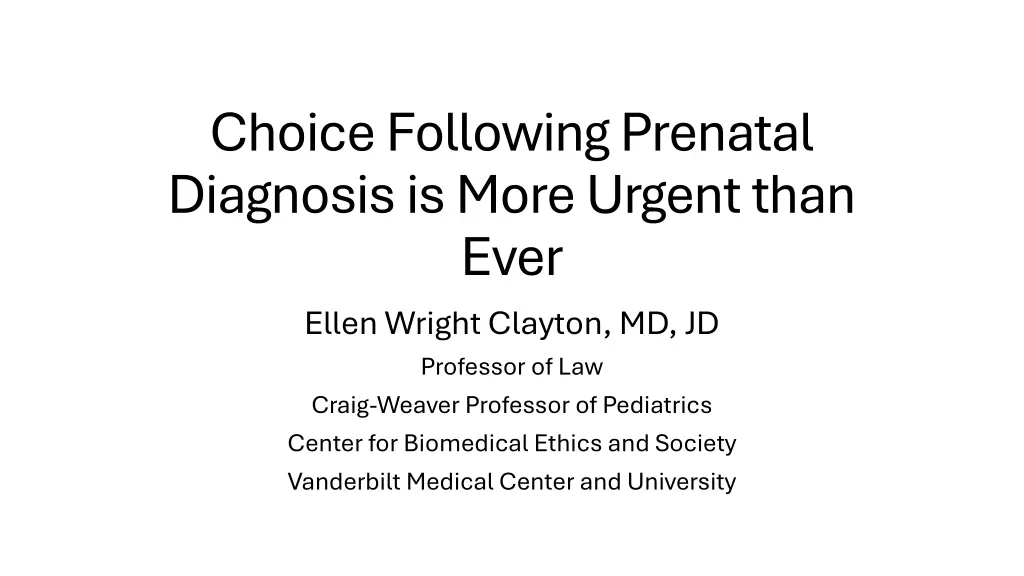
Urgency of Prenatal Diagnosis Options in Current Times
The urgency surrounding prenatal diagnosis has heightened due to advancements in noninvasive prenatal tests, leading to controversial abortion exemptions and bans across various states, with differing criteria for fetal anomalies. The landscape of prenatal care and decision-making has evolved significantly, reflecting changing societal attitudes and medical capabilities.
Download Presentation

Please find below an Image/Link to download the presentation.
The content on the website is provided AS IS for your information and personal use only. It may not be sold, licensed, or shared on other websites without obtaining consent from the author. If you encounter any issues during the download, it is possible that the publisher has removed the file from their server.
You are allowed to download the files provided on this website for personal or commercial use, subject to the condition that they are used lawfully. All files are the property of their respective owners.
The content on the website is provided AS IS for your information and personal use only. It may not be sold, licensed, or shared on other websites without obtaining consent from the author.
E N D
Presentation Transcript
Choice Following Prenatal Diagnosis is More Urgent than Ever Ellen Wright Clayton, MD, JD Professor of Law Craig-Weaver Professor of Pediatrics Center for Biomedical Ethics and Society Vanderbilt Medical Center and University
This issue has always been contested At that time, prenatal diagnosis was offered to limited number of people
What has changed? Noninvasive prenatal tests are recommended by obstetrical organizations for all pregnant women Administered at ~ 10 weeks Currently test for Trisomies 13, 18, and 21 as well as sex chromosome variants Disagree with Allyse, et al., HCR 2025 March-April Issue 29-38 Ultrasound has become more powerful and more routine History of Ultrasound in Obstetrics and Gynecology, Part 2 1970s yashojyotfetalmedicine.com
Examples of current abortion exemptions/bans 10 states have no exceptions for fetal anomalies 10 states have no exceptions for fetal anomalies States with limits for fetal anomalies States with limits for fetal anomalies AK, IN, NE, SD Lethal AK, IN, NE, SD Lethal fetal fetal anomaly anomaly means a fetalcondition diagnosed before birth that will result in the death of the unborn child with reasonable certainty within three (3) months of the birth WY WY Lethal Lethal fetal within hours of the child's birth IN IN Must be informed that Indiana does not allow a fetus to be aborted solely because of the fetus's race, color, national origin, ancestry, sex, or diagnosis or potential diagnosis of the fetus having Down syndrome or any other disability. see also KY fetal anomaly anomaly means a fetal condition diagnosed before birth and if the pregnancy results in a live birth there is a substantial likelihood of death of the child KY OK OK Fetal Fetal anomaly birth.Fetalanomaly incompatible with life does not include conditions which can be treated; anomaly incompatible with life incompatible with life means a profound and irremediable congenital or chromosomal anomaly that is incompatible with sustaining life after SC SC Fatal Fatal fetal with or without the provision of life-preserving treatment, would be incompatible with sustaining life after birth UT UT (9)(a) Severe brain abnormality Severe brain abnormality means a malformation or defect that causes an individual to live in a mentally vegetative state. (b) Severe brain abnormality does not include (i) Down syndrome; (ii) spina bifida; (iii) cerebral palsy; or iv)any other malformation, defect, or condition that does not cause an individual to live in a mentally vegetative state. NC NC Life Life- -limiting anomaly limiting anomaly. The diagnosis by a qualified physician of a physical or genetic condition that (i) is defined as a life-limiting disorder by current medical evidence and (ii) is uniformly diagnosable. fetal anomaly anomaly means that, in reasonable medical judgment, the unborn child has a profound and irremediable congenital or chromosomal anomaly that, WV WV Nonmedically viable fetus Nonmedically viable fetus means a fetus that contains sufficient lethal fetalanomalies so as to render the fetus medically futile or incompatible with life outside the womb in the reasonable medical judgment of a reasonably prudent physician. See also GA, IA, MS Limits on post Limits on post- -viability abortion for fetal anomalies viability abortion for fetal anomalies DL DL post viability permitted in the event of a fetal anomaly for which there is not a reasonable likelihood of the fetus's sustained survival outside the uterus without extraordinary medical measures ; see also MA MA GA, IA, MS
What about the argument from disability rights? Crucially, the discourse surrounding disabilities has changed dramatically in the last 50 years but support is still incomplete Many of the arguments about the adverse impact of abortion following prenatal diagnosis turn on misrepresentations of the impact of disability Women should receive accurate information about What tests may reveal, and If a problem is identified, condition, prognosis, and course of care here, Allyse, et al., are correct
What do the limits on abortion after prenatal diagnosis mean for women and their families? In more than one third of states, women must continue their pregnancies unless they can travel to a more permissive state What may lie in store? Possible prenatal intervention Surgery for spina bifida and other anomalies Intrauterine gene therapy trials Choosing to deliver at site where high-tech care is available NICU and cardiac surgery Long term specialty care in- and outpatient Increasing trend to hospital at home Many, but not all, women and families choose these interventions, which can dramatically affect children and families
But the ultimate question is whether women should be allowed to choose abortion after prenatal diagnosis The very technology that enables diagnosis and affects families is the reason why the answer is yes






















